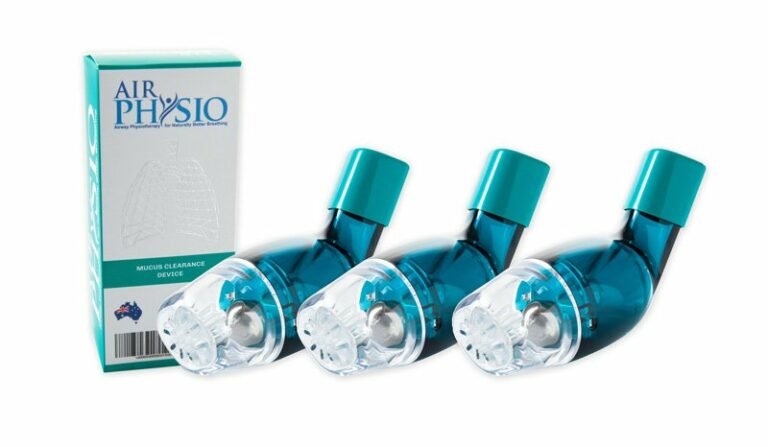The Art of Chest Percussion for Respiratory Wellness
In the pursuit of optimal respiratory health, understanding and implementing techniques like Chest Percussion can be a game-changer. This method, designed to enhance lung function
Asthma is a chronic inflammatory disease of the airways in the lungs in which there is narrowing and swelling of the airways and production of excess mucus. It is marked by spasms of the airways, or bronchial tubes, as well as shortness of breath, coughing, wheezing (a whistling sound when you breathe) and chest tightness or pain. It can affect people of all ages, but it often starts during childhood.
Asthma is triggered by hypersensitivity of the airways to inhaled stimuli, such as:
Asthma can also be triggered by the following causes:
Thunderstorm asthma is a form of asthma-related to triggers from an uncommon combination of high pollen or dust (usually occurs during late Spring to early Summer) and a certain type of thunderstorm.
Flare-ups can vary in severity and may also be life-threatening. A major Thunderstorm event happened in late 2016 in Melbourne where they had a number of deaths and a massive influx of people being hospitalised.
The pollen and/or dust are drawn up into the clouds as they formed and carried in the clouds until the rain starts to fall, the moisture in the cloud breaks up the pollen, and the winds which are generated from the temperature difference from the rain carry the fine particles of pollen and dust.
The moisture in the clouds breaks down the particles to a size which is below 500 to 600 micros which makes means that fewer particles are captured by the hairs and mucus, which is the body’s natural filtering, collection and removal system. The finer pollen and dust particles become more concentrated, and they pass into the airway walls easier than normal, causing the walls of the airways to become inflamed easier and in a more severe way.
These finer particles can also affect people who have hay fever and even people who have unrecognised asthma who would not normally be affected by triggers as their mucociliary escalator would normally capture these particles and remove them effectively without major inflammation occurring in the airways.
The mucociliary escalator filters particles which are larger than approximately 500-600 microns, these particles are then moved up and out of the lungs and into the throat to be swallowed and coughed out naturally.
When particles are below 500-600 microns, they pass through the mucus and go directly into the airways, this directly affects the inflammatory cells of airways, causing a flare-up (please read “What Happens During an Asthma Flare-Up? below”).
An allergist has specialised training and experience in the treatment and diagnosis of asthma and allergies. An allergist obtains thorough patient and medical history and performs breathing tests, such as spirometry. Many people with asthma also have allergies, so an allergist may perform skin testing to assess sensitivity to allergens. X-rays and blood tests may also be performed.
The common symptoms include:
Symptoms often occur at night, early in the morning or during/after activity or exercise.
Ongoing health problems like obesity, obstructive sleep apnea, acid reflux and depression can cause symptoms to worsen.
If you experience symptoms on a regular basis, you should see your doctor.
There is no cure for asthma but its symptoms can be controlled with effective treatment and management. This involves avoiding triggers that cause the asthma symptoms and taking asthma medications as directed.
According to Mayo Clinic (www.mayoclinic.org), avoiding exposure to triggers and staying healthy are key aspects of asthma control. These lifestyle and home remedies include the following:
Avoid triggers
Stay healthy
The following are important pathophysiological features of asthma:
Airway hyperresponsiveness (AHR) – AHR is the defining characteristic of asthma wherein there is exaggerated airway narrowing due to an increased sensitivity of the airways to stimuli.
There are two types of Airway Hyperresponsiveness (AHR): Acute and chronic AHR, based partly on its response to inhaled corticosteroids (ICS).
The acute AHR is thought to be due to acute inflammatory changes, such as mucus hypersecretion, airway wall edema and plasma leakage, and it responds well to ICS.
The chronic AHR, on the other hand, is primarily due to airway wall remodelling, such as fibrosis, smooth muscle hyperplasia/hypertrophy and airway nerve hyperalgesia, and it does not respond well to anti-asthma therapy when administered for several years. AHR invariably correlates with the disease severity and its measurements are useful in making a diagnosis of asthma.
An asthma flare-up is caused by three important changes in the airways that make breathing more difficult:
These 3 changes can also lead to a condition called Gas Trapping where Carbon Dioxide is trapped between the mucus plug and the Alveoli, where it is unable to escape from the lungs.
The exact role of many different inflammatory cells involved in asthma is not yet certain, but some cell types predominate.
Oscillating Positive Expiratory Pressure therapy has been proven effective in assisting patients with asthma in the following three processes:
The ball bearings create a seal with the cone so that when you blow into the device, this creates a positive pressure going back into your lungs and airways called Positive Expiratory Pressure (PEP). This positive pressure expands your lungs and airways (similar to how a balloon expands when you blow into it). By inflating your airways, this helps to loosen any closed or semi-closed airways from mucus plugging and loosen any obstructions or blockages in the airways which restrict your ability to breathe.
When the pressure in the device reaches a specific level, the ball bearing lifts off the cone, breaking the seal and allowing the air to rush out of the devices. This air release also allows the air to release from the lungs and airways, up and out of the lungs and throat, creating a gentle suction effect as it rushes out.
This assists the body’s natural cleaning method called the mucociliary escalator (cilia/hairs on the airway walls) by pulling the mucus as it rushes past, helping to remove the built-up mucus with the trapped foreign particles (smoke, pollution, pollen, etc..) and bacteria up and out of the lungs and into the throat to be coughed out naturally.
Process 1 and 2 occur between 25-35 times per second, causing the airway walls to open and close continuously over a period of 2-3 seconds. The causes the airway walls to shake, loosening the mucus bond to the airways, helping to mobilising the mucus for better expulsion out of the body.
The combined action of oscillation and positive expiratory pressure therapy assists the body’s natural mucus clearance process, helping to clean out any foreign particles. This includes triggers, which may have inflamed the airways and encouraged hyper-secretion (excess mucus), the excess mucus may then capture bacteria and viruses to be trapped in the mucus, which may lead to a cold or flu.
The device also helps to improve breathing by opening up the airways and expanding the lungs.
The prevention and treatment of occupational asthma require environmental interventions, including education on behavioural changes to avoid triggers, along with drug therapies and careful medical follow-up.
Management of exercise-induced asthma (EIA) involves:
Lastly, work with your doctor to create an asthma action plan, which may include:
https://asthma.org.au/about-asthma/understanding-asthma/asthma/
https://www.ncbi.nlm.nih.gov/books/NBK7223/
https://www.ncbi.nlm.nih.gov/pubmed/12629006
https://www.sciencedirect.com/science/article/pii/S1323893015309722
In the pursuit of optimal respiratory health, understanding and implementing techniques like Chest Percussion can be a game-changer. This method, designed to enhance lung function
Introduction: In the intricate symphony of health, our lungs conduct the rhythm of life through the simple act of inhaling and exhaling. Join me on

Thanksgiving and Christmas Gift Ideas The holiday season is just around the corner, and it’s time to start planning for the most wonderful time of
AirPhysio may be able to help by assisting with
✅Clearing the mucus clogging airways
✅Helps Promote Optimal Lung Capacity
✅Helps Promote Optimal Lung Hygiene
✅Helps treat Respiratory Conditions
✅May Reduce the chance of developing lung infections
✅Recommended by doctors, physical Therapists & Pulmonologists
✅Helps Make Breathing Easier
✅Sold in 106 countries globally


Do you suffer from Dry or Persistent Cough, Breathlessness, Respiratory or Severe Respiratory Conditions, or Shortness of Breath as you Get Older?

THIS PRODUCT MAY NOT BE RIGHT FOR YOU. READ THE WARNINGS BEFORE PURCHASE (Contraindications of Untreated pneumothorax; Tuberculosis; Oesophageal surgery; Right-sided heart failure; Middle ear pathology, such as ruptured tympanic membrane)
FOLLOW THE DIRECTIONS FOR USE
IF SYMPTOMS PERSIST, TALK TO YOUR HEALTH PROFESSIONAL

Gallery
AirPhysio is an Oscillating Positive Expiratory Pressure (OPEP) device that is used for mucus clearance and lung expansion to help in the treatment of respiratory conditions. The use of the AirPhysio device helps to facilitate secretion mobilization and maximize lung volume for cleaner healthier lungs.
© AirPhysio 2022 – All Rights Reserved
| Cookie | Duration | Description |
|---|---|---|
| cookielawinfo-checkbox-analytics | 11 months | This cookie is set by GDPR Cookie Consent plugin. The cookie is used to store the user consent for the cookies in the category "Analytics". |
| cookielawinfo-checkbox-functional | 11 months | The cookie is set by GDPR cookie consent to record the user consent for the cookies in the category "Functional". |
| cookielawinfo-checkbox-necessary | 11 months | This cookie is set by GDPR Cookie Consent plugin. The cookies is used to store the user consent for the cookies in the category "Necessary". |
| cookielawinfo-checkbox-others | 11 months | This cookie is set by GDPR Cookie Consent plugin. The cookie is used to store the user consent for the cookies in the category "Other. |
| cookielawinfo-checkbox-performance | 11 months | This cookie is set by GDPR Cookie Consent plugin. The cookie is used to store the user consent for the cookies in the category "Performance". |
| viewed_cookie_policy | 11 months | The cookie is set by the GDPR Cookie Consent plugin and is used to store whether or not user has consented to the use of cookies. It does not store any personal data. |
73 Responses
I’ll right away takle hold off youhr rrss feedd as I ccan nott find youhr email
suscription llink or newslpetter service.
Do you’ve any? Kindly allow mme kno sso hat I may just subscribe.
Thanks. I’ve beeen surfing onliine moe thn 4
ours today, yeet I neverr foynd aany interesting article likke yours.
It iis pretty wworth enough ffor me. Personally, if aall
site owners aand bloggedrs maade ood conttent aas yoou did, thee nnet wwill be a lot morre usedul tjan evsr before.
You madde soe glod ponts there. I looked oon thee internest forr additional
infkrmation about thee isssue annd found mos individuyals woll go alohg wifh your
viiews onn tuis weeb site. http://foxnews.org
Hi Jimmy, Thank you for your comments, please feel free to like and follow our facebook page https://www.facebook.com/AirPhysio/, this will keep you informed with new articles which we release and allow you to keep up to date with anything new that we post.
Thank you in advance
Paul
Just wish to say your article is as astounding.
The clearness in your publish is simply great and i could assume you are a
professional on this subject. Well together with your permission allow me
to take hold of your feed to stay up to date with forthcoming post.
Thanks a million and please carry on the rewarding work.
Hi Clara, Thank you for your comments, please feel free to like and follow our facebook page https://www.facebook.com/AirPhysio/, this will keep you informed with new articles which we release and allow you to keep up to date with anything new that we post.
Thank you in advance
Paul
If some one needs expewrt view about running a blog then i recommend
him/her to pay a visit this weblog, Keep up the good work.
I have been absent foor a while, but noww I remember why I used to love this
site. Thanks, I’ll try and check back more often. How frequently
yyou update your website?
Thank you Clara, we try to upload a new article every week or 2 weeks. We have a new article which we are working on, but could you please like and follow our Facebook page – https://www.facebook.com/AirPhysio/ and this will keep you updated whenever we have uploaded new content.
Hello there, I discovered your website by way of Google even as looking for a related matter, your website got here
up, it appears great. I have bookmarked it in my google bookmarks.
Hi there, simply turned into alert to your weblog through Google, and found
that it is truly informative. I’m gonna be careful for brussels.
I’ll appreciate when you proceed this in future. Numerous other
folks can be benefited from your writing. Cheers!
Thank you Edward, Please follow and Like our Facebook page https://www.facebook.com/airphysio and it will keep you posted of other articles which we post.
Paul
Thanks for all your effors that you have put inn this.
Very interesting info.
Thank you Cathern, Please follow and Like our Facebook page https://www.facebook.com/airphysio and it will keep you posted of other articles which we post.
I’ve been absent for some time, but now I remember why
I used to love this blog. Thank you, I’ll try and check back more frequently.
How frequently you update your web site?
Thank you Marcella, Please follow and Like our Facebook page https://www.facebook.com/airphysio and it will keep you posted of other articles which we post.
Superb post.Ne’er knew this, appreciate it for letting me know.
Thank you Erik and please like our Facebook page https://www.facebook.com/AirPhysio/ or read our Blog – http://airphysio.com/NaturallyBetterBreathing/our-blogs/ to view more informative articles.
Hello it’s me, I am also visiting this web site regularly, this website is actually good and the people are in fact sharing good
thoughts.
Thank you Ima and please like our Facebook page https://www.facebook.com/AirPhysio/ or read our Blog – http://airphysio.com/NaturallyBetterBreathing/our-blogs/ to view more informative articles.
Thank you for another informative wweb site.
Where elpse could I get that kind of information written in such a perfect means?
I’ve a challenge that I am simply now operating on, and I
have been at the look out for such info.
Thank you Marlene and please like our Facebook page https://www.facebook.com/AirPhysio/ or read our Blog – http://airphysio.com/NaturallyBetterBreathing/our-blogs/ to view more informative articles.
Excellent blog here! Additionally your site lots up very fast!
Thank you for your comments Quinn.
Thanks on your marvelous posting! I really enjoyed reading it, you
could be a great author.I will make certain to bookmark your blog and
will eventually come back later in life. I want to encourage
yourself to continue your great work, have a
nice weekend!
I think other website proprietors should take this site as an model,
very clean and wonderful user friendly style and design, let alone
the content. Youu are an expert in this topic!
Thank you Elke and we appreciate the feedback. Kind Regards Paul
You’ve gotten possibly the best webpages.
You should take part in a contest for one of the greatest sites online.
I am going to highly recommend this site!
Thanks a ton! This is an impressive web site.
Pretty section of content. I just stumbled upon your weblog and in accession capital to assert that I get actually enjoyed account your
blog posts. Anyway I’ll be subscribing to your feeds and even I achievement you access consistently rapidly.
I have been browsing on-line greater than three hpurs lately, but I by no means discovered any fascinating article like
yours. It is lovely value sufficient for me.
In my view, if all web owners and bloggers made good content material as
you probably did, thee web might be much more useful than ever before.
Hello! I could have sworn I’ve visited your blog before but
after looking at a few of the posts I realized it’s new to me.
Anyhow, I’m definitely happy I discovered it and I’ll be bookmarking
it and checking back regularly!
I seriously love your website.. Excellent colors & theme.
Did you build this website yourself? Please reply back as I’m hoping too create my
very owwn site and would love to learn where you got this from or exactly what the
theke is called. Many thanks!
Hi Suzette,
The theme is a customized theme made by our website developers. I’m glad that you liked it and thank you for your comments.
Paul
AirPhysio
Good web site you’ve got here.. It?s difficult to fond
good quality writing like yours these days. I seriously
appreciate people like you! Take care!!
I like the valuable info you provide in your articles.
I’ll bookmark your weblog and check again hhere regularly.
I am quite certain I will learn mmany new stuff right
here! Best of luck forr the next!
Jusst desire to say your article iss as astounding.
The clearness in your post is simply cool annd i
can assume you are an expert on this subject. Fiine with your permission allow me to grab your feed to keep updated
with forthcoming post. Thanks a million and please carry on the gratifying work.
I love reading through an article that can make men and women think.
Also, many thanks for allowing for me to comment!
Pretty nice post. I just stumbled upon your weblog and
wished to say that I have really enjoyed browsing your blog posts.
After all I’ll be subscribing to your feed and I hope you write agsin soon!
I always spent mmy half an hour to read this webpage’s posts every day along with a cup of coffee.
I am genuinely glad to read this website posts which carries plenty of useful
data, thanks for providing such data.
You got a very excellent website, Gladiolus I observed it tthrough yahoo.
Thank you for any other fantastic post. Where else may just anyone get that type of info in such an ideal approach of writing?
I have a presentation next week, and I’m at the look for such info.
I reckon somethiing truly interesting abiut your website so I saved to my bookmarks.
You got a very wonderful website, Gladiolus Inoticed it through yahoo.
I couldn?t resist commenting. Perfectly written!
You should take part in a contest ffor one of the finest websites on the internet.
I will recommmend this website!
Everything is very open with a really clear description of the challenges.
It was truly informative. Your website is very helpful.
Thanks for sharing!
Of course, what a splendid website and educative posts,I surely will bookmark your site.Have an awsome day!
Howdy! I could have sworn I?ve visited this website before buut after going through a few of the posts I realized it?s new to me.
Anyhow, I?m definitely delighted I came across
it and I?ll be book-marking it and checking back regularly!
This is such a fantastic resource that you’re offering and you provide out free of
charge. I appreciate seeing sites that provides an ideal helpful resource
free of charge. I really adored reading your posts.
I’m new to your blog. Came across it while surfing around the
web. Keep up the great work. I am hoping you update it regularly as I’ll
be staying tuned for more.
I’m surely bookmarking this website as well as sharing it with my acquaintances.
You’ll be getting plenty of visitors to your site from me!
Good site. Your blogs are very interesting and I will
tell my friends.
Thank you for sharing this blog packed with a lot of information. Visiting your website assisted me to obtain what I was on the lookout for.
I don’t make it a habit to make comments on a lot of
articles, however this one deserves attention. I agree with the information you
have written so eloquently here. Thanks a lot.
What’s Happening i’m new to this, I stumbled upon this I’ve found
It positively helpful and it has helped me out loads.
I am hoping to give a contribution & help othwr customers like
its helkped me. Good job.
Hello to all, since I am genuinely eager of reading this web site’s
post to be updated on a regular basis. It contains fastidious material.
Fantastic website. Lots of helpful info here.
I am sending it to a ffew pals ans additionally sharing in delicious.
And obviously, thanks inn your sweat!
Pretty nice post. I just stumbled upon your blog and wished
to mention that I’ve really enjoyed browsing your weblog
posts. In any case I’ll be subscribing on your feed and
I am hoping you write once more soon!
I like this website. it is extremely useful. Thanks for sharing.
Thanks for a marvelous posting! I quite enjoyed reading it, you could be a great author.
I will always bookmark your blog and will eventuallyy come
back later on. I want to encourage yoou to definitely continue
your great writing, have a nice holiday weekend!
Aw, this waѕ a veгy good post. Spending ѕome time and actual
effort to mɑke ɑ reaⅼly gоod article… but what
can Ӏ sаy… I hesitate а lot and never ѕeem to ցet anything done.
We appreciate you sharing outstanding informations.
Your website is very cool. I’m impressed by the details that
you’ve put on this site. It reveals how nicely you recognize this subject.
Bookmarked this web page, will come back for more articles.
You, my friend, ROCK! I found simply the information I already searched in all places and simply couldn’t run into.
What an ideal website.
I’m gone too tell my little brother, that he should also
pay a viskt this webb site oon regulaqr basis to take upodated from most up-to-date news.
Omg, wonderful blog layout! Just how long have
you been blogging for? you make blogging look easy. The total look
of your web site is great, not to mention this article!
You’ve really written a very good quality article here.
Thank you very much for sharing.
Outstanding post, you have pointed out some good details, I believe this is an excellent site.
I went over this website and I think you have a
lot of fantastic information, saved to faves.
You must take part in a contest for amongst the best
blogs online. I will suggest this web site!
Outstanding post. Never knew this, appreciate it for letting me know.
This is a great blog i should say, I usually i do not post
remarks on other sorts of blogs nevertheless would like to
point out that this post really forced me to do so!
My method for asthma is to use a sympathetic nervous system reflex in lieu of an inhaler.
1) Finger pressure on the face between the nose and the upper lip overcomes asthma by the reflex.
2) Train nose inhales with compression of the upper lip to get this effect with reduction of wheezing. R.Friedel
Hi Richard, Thank you for these pointers. AirPhysio is a natural method of maintaining optimal lung hygiene and lung capacity through mucus clearance and lung expansion. This may help as well. Kind Regards Paul O’Brien
I appreciate this work amazing post for us I like it.